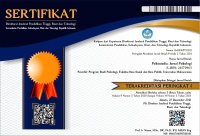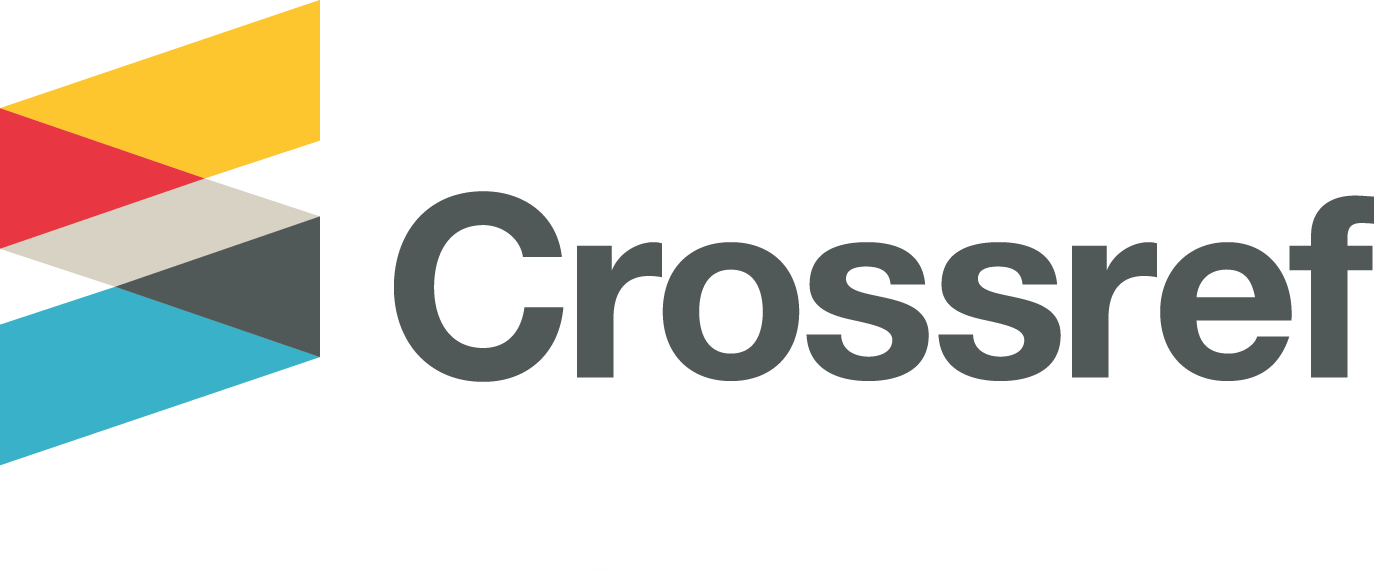Construction of Indonesian Executive Function Self-Report Scale (IEF-SRS)
Abstract
Dementia is a cognitive disorder that can affect not only older people but also those who are still young. This condition is called early onset dementia, or EOD, and one of the cognitive functions that is being affected by EOD is executive function. During the period when this research was conducted, Indonesia was still amidst COVID-19 pandemic. This fact is one of the reasons why most people could not leave their homes. This posed a challenge for individuals who wanted to perform an early detection of EOD through cognitive assessments because most of the measurement test for executive function require the tester and the testee to meet face-to-face. Furthermore, there has not been much availability of executive function scales with a self-report format in Indonesia. Based on these phenomena, the researchers decided to develop a measurement test for executive functions for individuals aged 18 and above, to detect EOD. The test consists of 42 items written based on Lezak’s (1982) executive function model. After being tested on 497 participants aged 18-75 years old, the items exhibited high reliability (α=0.841) and strong validity evidence (RSMEA=0.071; GFI=0.99; NFI=0.99; CFI=0.99; IFI=0.99).
Demensia merupakan penyakit kognitif yang dapat menyerang tidak hanya lansia, namun juga kaum muda. Penyakit tersebut dinamakan early onset dementia (EOD) dengan salah satu fungsi individu yang dapat terganggu adalah fungsi eksekutif. Pada waktu penelitian ini disusun, Indonesia masih berada pada masa pandemi COVID-19. Hal tersebut menyebabkan banyak orang kesulitan untuk keluar rumah. Hal ini menjadi tantangan bagi individu yang ingin melakukan deteksi dini terhadap EOD karena pada umumnya alat ukur fungsi eksekutif harus dilakukan secara tatap muka. Selain itu, belum banyak alat ukur fungsi eksekutif yang berbentuk self-report. Berangkat dari hal ini, peneliti memutuskan untuk melakukan konstruksi alat ukur fungsi eksekutif untuk individu dari berbagai kalangan usia, sebagai salah satu usaha untuk mendeteksi dini gangguan fungsi kognitif pada individu. Item-item alat ukur ini disusun berdasarkan empat dimensi fungsi eksekutif menurut Lezak (1982;2012). Setelah diujikan pada 497 orang partisipan berusia 18-75 tahun, didapatkan hasil bahwa alat ukur IEF-SRS memiliki reliabilitas (α=0.841) dan bukti validitas (RSMEA=0.071; GFI=0.99; NFI=0.99; CFI=0.99; IFI=0.99) yang baik.
Keywords
Full Text:
FULL TEXTReferences
Badan Pusat Statistik. (2020). Statistik Indonesia 2020. Jakarta, Indonesia. Retrieved from https://www.bps.go.id/publication/2020/04/29/e9011b3155d45d70823c141f/statistik-indonesia-2020.html
Berberian, A. A., Gadelha, A., Dias, N. M., Mecca, T. P., Comfort, W. E., Bressan, R. A., & Lacerda, A. T. (2018). Component mechanisms of executive function in schizophrenia and their contribution to functional outcomes. Brazilian Journal of Psychiatry. doi:10.1590/1516-4446-2018-0021
Bigio, E. H., Hynan, L. S., Sontag, E., Satumtira, S., & White, C. L. (2002). Synapse loss is greater in persenile than senile onset Alzheimer disease: Implication for the cognitive reserve hypothesis. Neuropathology and Applied Neurobiology, 28(3), 218-227. doi: 10.1046/j.1365-2990.2002.00385.x.
Cohen, R. J. & Swedlik, M. E. (2009). Psychological Testing and Assessment: An Introduction to Tests and Measurement (7th ed.). Mc-Graw Hill.
Cortina, J. M. (1993). What is Coefficient Alpha? An Examination of Theory and Applications. Journal of Applied Psychology, 78(1), 98-104.
Creswell, J. W. (2012). Educational Research: Planning, Conducting and Evaluating Quantitative and Qualitative Research (4th ed.). MA: Pearson Education.
Cronbach, L. J. (1951). Coefficient alpha and the internal structure of test. Psychometrika, 16, 297-334.
Duke, L. M., & Kaszniak, A. W. (2000). Executive Control Functions in Degenerative Dementias: A Comparative Review. Neuropsychology Review, 10(2), 75-99. DOI:10.1023/A:1009096603879
Fadil, H., Borazanci, A., Ait Ben Haddou, E., Yahyaoui, M., Korniychuk, E., Jaffe, S. L., & Minagar, A. (2009). Chapter 13: Early Onset Dementia. Neurobiology of Dementia, 245-262. doi:10.1016/s0074-7742(09)00413-9
Hair Jr., J. F., Black, W. C., Babin, B. J. & Anderson, R. E. (2014). Multivariate Data Analysis (7th Edition). Harlow: Pearson New International Edition.
Hershey L. A. (1996). Dementia: not always a disease of the elderly. Seminars in neurology, 16(1), 41–46. https://doi.org/10.1055/s-2008-1040958
Hull, R., Martin, R. C., Beier, M. E., Lane, D. & Hamilton, A. C. (2008). Executive Function in Older Adults: A Structural Equation Modeling Approach. Neuropsychology. 22(4). 508-522. DOI: 10.1037/0894-4105.22.4.508
Kaplan, R. M. & Saccuzzo, D. P. (1997). Psychological Testing: Principles, Applications and Issues (4th ed.) Monterey: Brooks/Cole.
Kolb, B. & Whishaw, I. Q. (2015) Fundamentals of Human Neuropsychology (7th ed.) New York: Worth Publishers.
Kuruppu, D. K., & Matthews, B. R. (2013). Young-onset dementia. Seminars in neurology, 33(4), 365–385. https://doi.org/10.1055/s-0033-1359320
Lee, G. P., Strauss, E., Loring, D., McCloskey, L., Haworth, J. M. & Lehman, R. A. (1997). Sensitivity of Figural Fluency on the Five-Point Test to Focal Neurological Dysfunction. The Clinical Neuropsychologist, 11(1), 59-68.
Levine, R. (2006). Defying Dementia: Understanding and Preventing Alzheimer’s and Related Disorders. Connecticut, London: Praeger. and Related Disorders. Connecticut, London: Praeger.
Lezak, M. D. (1982). The Problem of Assessing Executive Functions. International Journal of Psychology, 17(1-4), 281–297. doi:10.1080/00207598208247445
Lezak, M. D. (1993). Newer Contributions to the Neuropsychological Assessment of Executive Functions. Journal of Head Trauma Rehabilitation, 8(1), 24-31. http://dx.doi.org/10.1097/00001199-199303000-00004
Lezak, M.D. (1994). Domains of behavior from a neuropsychological perspective: The whole story. In Integrative Views of Motivation, Cognition, and Emotion: Volume 41 of the Nebraska Symposium on Motivation, University of Nebraska Press, Lincoln, pp. 23–55.
Lezak, M. D., Howieson, D. B., Bigler, E. D., & Tranel, D. (2012). Neuropsychological Assessment (5th Ed.). Oxford University Press: New York.
Likert, R. (1932). A technique for the measurement of attitudes. Archives of Psychology, 22(140), 1-55.
Linacre, J. M. (2002). What do Infit and Outfit, Mean Square and Standardized mean? Rasch Measurement Transactions, 16(2), 878. Retrieved from https://www.rasch.org/rmt/rmt162f.htm
Lunz, M. E. (2010). Using The Very Useful Wright Map. Retrieved from https://www.rasch.org/mra/mra-01-10.htm
Magno, C. (2009). Demonstrating the Difference between Classical Test Theory and Item Response Theory Using Derived Test Data. The International Journal of Educational and Psychological Assessment, 1(1). 1-11.
McMutray, A., Clark, D. G., Christine, D., & Mendez, M. F. (2006). Early-Onset Dementia: Frequency and Causes Compared to Late-Onset Dementia. Dementia and Geriatric Cognitive Disorders. 21, 59-64. Doi: 10.1159/00008954
Miyake, A., Friedman, N. P., Emerson, M. J., Witzki, A. H., Howerter, A., & Wager, T. D. (2000). The Unity and Diversity of Executive Functions and Their Contributions to Complex “Frontal Lobe” Tasks: A Latent Variable Analysis. Cognitive Psychology, 41(1), 49–100. doi: 10.1006/cogp.1999.0734
Miyoshi, K. (2009). What is “early onset dementia?” Psychogeriatrics. 9(2), 67-72. doi:10.1111/j.1479-8301.2009.00274.x
Monsell, S. (1996). Control of mental processes. In V. Bruce (Ed.). Unsolved mysteries of the mind: Tutorial essays in cognition, 93–148. Hove, UK: Erlbaum.
Pandita, G. (2020, Oktober). Pencegahan Demensia Sejak Remaja. PPT dipresentasikan pada Seminar Online Alzheimer’s Indonesia Pusat, Jakarta, Indonesia.
Regard, M., Strauss, E., & Knapp, P. (1982). Children’s Production on Verbal and Non-Verbal Fluency Tasks. Perceptual and Motor Skills, 55(3), 839–844. doi:10.2466/pms.1982.55.3.839
Royall, D. R., Lauterbach, E. C., Cummings, J. L., Reeve, A., Rummans, T. A., Kaufer, D. I., LaFrance, W. C., & Coffey, C. E. (2002). Executive Control Function. The Journal of Neuropsychiatry and Clinical Neurosciences, 14(4), 377-405. doi:10.1176/jnp.14.4.377
Tindall, L & Manthrope, J. (1997). Early onset dementia: A case of ill-timing? Journal of Mental Health. 6(3), 237-249. doi:10.1080/09638239718770
Urbina, A. (2014). Essentials of Psychological Testing (2nd Edition). NJ: Wiley.
Vieira, R. T., Caizeta, L., Machado, S., Silva, A. C. Nardi, A. E., Arias-Carrion, O., & Carta, M. G. (2013). Epidemiology of early-onset dementia: a review of the literature. Clinical Practice & Epidemiology in Mental Health. 9, 88-95.
Voss, S. E. & Bullock, R A. (2004). Executive Function: The Core Feature of Dementia? Dementia and Geriatric Cognitive Disorder. 18(2), 207-216. DOI: 10.1159/000079202
Werner, P., Stein-Shvachman, I., & Korczyn, A. D. (2009). Early onset dementia: clinical and social aspects. International Psychogeriatrics. 21(4), 631-636
Willoughby, M. T. & Blair, C. B. (2016). Measuring Executive Function in Early Childhood: A Case for Formative Measurement. Psychological Assessment. 28(3), 319-330. http://dx.doi.org/10.1037/pas0000152
Wright, B.D. & Linacre, J. M. (1994). Reasonable Mean-Square Fit Values. Rasch Measurement Transaction. 8(3), 370. Retrieved from https://www.rasch.org/rmt/rmt83b.html
DOI: http://dx.doi.org/10.30872/psikostudia.v13i1.12918
Refbacks
- There are currently no refbacks.
Copyright (c) 2024 Virginia Geraldine Hanny Prasetya & Hery Susanto

This work is licensed under a Creative Commons Attribution-ShareAlike 4.0 International License.
Psikostudia: Jurnal Psikologi is indexed by :
PSIKOSTUDIA: Jurnal Psikologi Published by Faculty of Social and Political Siences, University of Mulawarman, Samarinda, East Kalimantan and This work is licensed under a Creative Commons Attribution-ShareAlike 4.0 International License.
_________________________________________
PSIKOSTUDIA: Jurnal Psikologi
Department of Psychology
Faculty of Social and Political Siences, University of Mulawarman
Jl. Muara Muntai Kampus Gn. Kelua Samarinda 75411
Phone: +62 813 35350368
E-Mail: psikostudia@fisip.unmul.ac.id




















